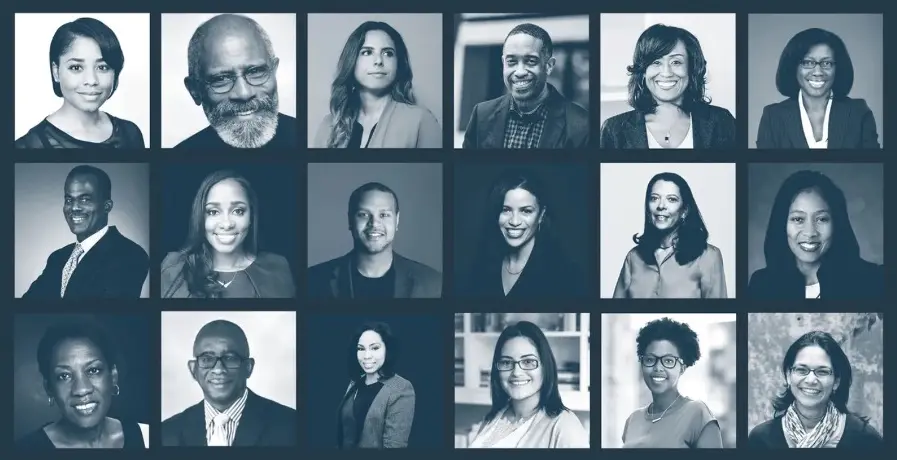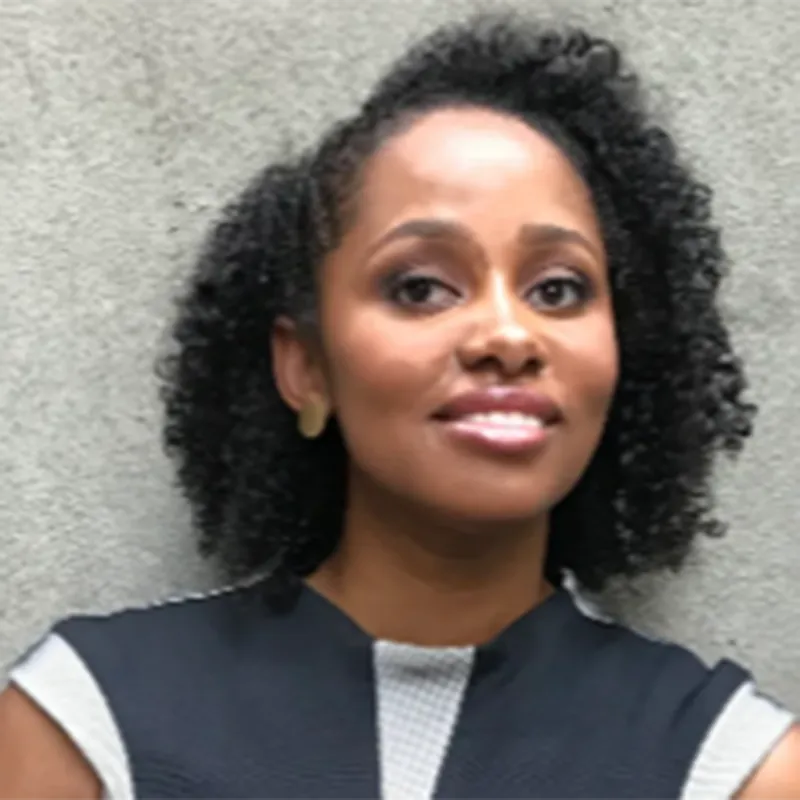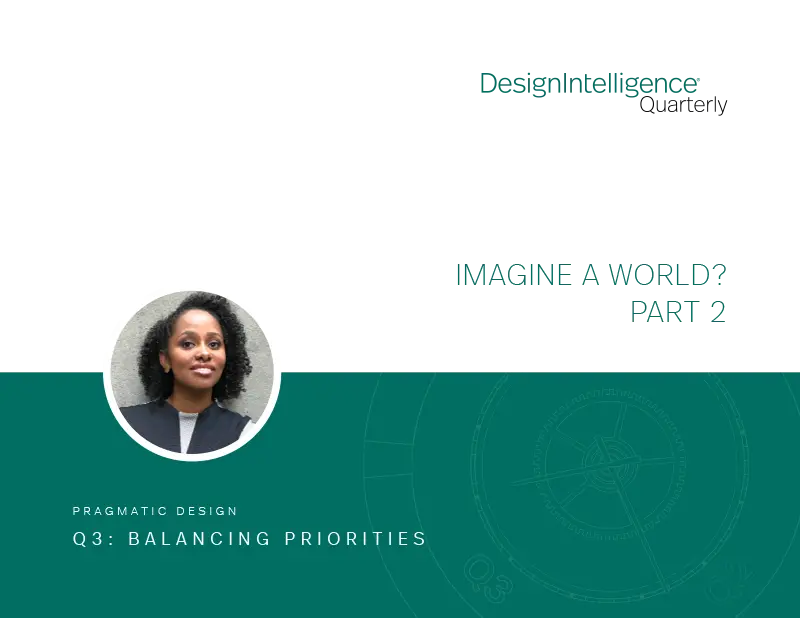Imagine a World: Part 2
by Pascale Sablan, FAIA
NOMA Global President
Founder, Beyond the Built Environment
Associate Principal, Adjaye Associates Architects
August 9, 2023
Pascale Sablan connects advocacy and architecture.
Editor's Note: This week we continue our interview with architect-activist Pascale Sablan. For last week's Part 1 context, click here.
DesignIntelligence/Michael LeFevre (DI): Pascale Sablan, congrats on your NOMA presidency.
Pascale Sablan (PS): NOMA has had an incredible lineage and legacy of powerful presidents. I think I'm the 35th president of the organization, and it's fifth woman president. I really wanted to make sure I was showing up to this leadership role with my unique skillset and talents. Success for me is making sure I walk away from this position as president leaving NOMA in a stronger, more organized, more powerful, more strategically positioned place than it was when I found it.
I want to make it better. I know I will not solve all things, but I want to make sure every member feels seen, heard and focused on. I want everyone to feel knowledgeable and informed, and I also want to make sure future leaders see a path into this seat and this position. I want the organization to leverage some of the structure and work I'm doing to facilitate and build upon the successes of all the prior presidents as well.
DI: I went to the AIA convention in Detroit in 1968 as a young intern architect. That event is part of NOMA's origin story.
PS: You were there when Whitney M. Young gave the speech?
DI: I've read it. I was not present at his speech, I just happened to be at the convention.
PS: Most of our NOMA founders were in the audience and heard that challenge. They got together three years later, in 1971, and formed NOMA. That got us going. That was what inspired the conversation: What are we doing to make the profession more just? That's why me winning the AIA Whitney M. Young Jr. Award in 2021 was so significant, because it felt like a full-circle moment as it relates to all the different avenues and parts of my life that came together.
DI: Let's stay on leadership, broadly. We've talked about how leadership came to you. As a profession, we have not been very good exemplars as leaders. We have been self-focused, and our culture has wrongly rewarded that. We have traditionally cared about our buildings, ourselves, our egos and not enough about our clients. There aren't enough leadership role models for architects. You're now carrying the mantle of leadership responsibility within your work in advocacy and inclusion, and in the profession. Where can we find more leverage to create more leaders? We're not very good at it compared with others, in my view.

PS: I'm challenged by the language that architects in general are not great leaders, because I think it's a generalization. What I am comfortable with saying is that we haven't historically challenged the profession to look outwardly enough. We've published or defined success and greatness in the profession of architecture, by standards that are a bit more self-serving, and rarely on metrics that impact greater society. I'll accept that. But I won't say the profession hasn't had good leaders because we are leaders in how we work. We are leaders in the way we structure our teams and educate our clients. We are leaders in the way we're changing the built environment and the work we're doing through advocacy. There are a lot of great leaders who've been doing great work at the core of the profession.
Developing leadership is an investment in individuals. It can't be simply: These are the tools we apply to everyone because they're equal. It requires understanding where people are and being able to identify potential paths of leadership in a diverse pool of people while not expecting every single person to be a leader. And having the comfort and grace to not only be leaders, but also to be amazing followers. There are a lot of spaces I walk into where I'm not the leader and I'm okay with that. There are a lot of places I step into because that's what's necessary.
The idea of being a leader isn't all-encompassing and permanent. It really is about the space, environment, people and mission you're trying to serve. Sometimes you acknowledge you are in a position as an apprentice. In this moment you are literally learning in the infancy of an understanding of the information and material. Sometimes you're in the position of mentor, where you are absorbing and sharing knowledge. And sometimes you are the leader making decisions not everyone will be excited about, but that you hold as the best option for the greater good.
There's also the position to teach, to identify the characteristics of leadership needed in certain spaces because it's not always going to be the same. The awareness of the nuances and multiple facets of leadership is important in defining that. Because the more you can showcase all those different elements, people can see themselves in different leadership positions depending on the chemistry of the issue.

In a position of leadership, I absolutely can step forward as it relates to issues about people of color. I feel confident stepping into that role as it relates to women or parents. I do not feel that role as it relates to people with disabilities or people who are LGBTQ+, yet I'm down for the mission. I want to help, but I can't be a leader in that space. I'm an apprentice or supporter or advocate in that space. Those tools are necessary, whether they be policy writing, public speaking or strategy development, and they can all be taught. Celebrating projects that are sustainable and give back to Mother Earth rather than extracting from it are other ways of diversifying what it is lead in this profession.
DI: I respect your redirection and reframing of my question. At DI we're spending a lot of time talking about those things, the growing realm of the architect's responsibilities. That's at the core of what I was trying to get at there. For too long we thought it's been about us and our buildings and it's not. It never should have been. Okay, the floor is yours. You've got all the billboards in Times Square. What do they say to get your message out?
PS: If it's in Times Square and I have the attention of society ... ?
DI: Going to context immediately …
PS: Yes. The message I would want out there is you have a role in designing and deciding your built environment and community. Architects are resources excited to work with you.
DI: When you say “you,” you mean the world at large?
PS: Yes. The world at large.
DI: What else do you have going on?
PS: While I've I stepped down as executive director of Beyond the Built Environment, I'm still the founder. It now has an executive director and board in place and is officially a nonprofit of New York state that's continuing to do programs, events like “SAY IT LOUD” exhibitions, and it is working toward launching the augmented reality app and publishing a series of children's books that identify the work and identities of all the women and BIPOC designers.

Image courtesy of Pascale Sablan and Great Diverse Designers Library
With NOMA, and my presidency, it's an organization that has been founded and has continued to advocate and fight for a just and equitable profession. We have an amazing conference happening October 11 to 15 in Portland, Oregon. We're looking for sponsors, attendees, speakers and people to engage and network.
The door is open. Part of my presidential platform is taking NOMA global. We're looking at communities across the world that could start and found NOMA chapters. Wherever this article is reaching you, please consider forming a local NOMA chapter that can be part the force that helps push our mission and our agenda in a way that allows us to share resources and to realize this beautiful future as quickly as possible.
I try to remain accessible, although I am all over the place. You can find me on social media on Instagram and on LinkedIn. I want to hear about people's amazing work and contributions and always find the time to cheer on those who have recently become licensed and are working toward that. If you are an African American / Black architect who will become licensed and have not submitted your name and information to the directory of African American architects, I encourage you to do so, so we can continue to keep an accurate record of our progress that will help us continue to transform this profession and realize our 2030 goal and beyond.
One of our other programs is the Say It with Media Pledge, which tracks the number of women and BIPOC designers featured in media publications, digital, print and broadcast. Our goal is to increase the number by 5% every year until a minimum of 15% is reached. We use the platform to share the story about how architecture can be used to heal and how it has been leveraged. Here's the link: https://www.beyondthebuilt.com/say-it-with-media.

It's online and there's no fee. It tries to leverage all this incredible content we're gathering with all these exhibitions like “SAY IT LOUD” to promote the identities and work of the people doing it. You can see the nine publications who've already taken the pledge. The Great Diverse Designers Library has the work and profiles of the 972 designers featured in our 37 exhibitions so far.
DI: Amazing. You are carrying a big load and we thank you for that. Looking at some future forwarding and visioning with the amazing early and midcareer you've already had, what do you look like in 20 years, in 2043? How might your view be different? Have you dreamed that far ahead?
PS: In 20 years, I'll be watching my son become a licensed architect. In 20 years, now that we've eradicated all these oppressions, we'll be imagining a new world and seeing it constructed in ways that are inclusive and just. We'll be living in a space where the built environment is emblematic of society, the policies and laws reflect that inclusive value. I dream that the built environment is audacious in realizing a changed society and the ways we govern that are emblematic of that system.
DI: A beautiful dream. Thank you. I have every confidence that if we're not there, we'll be well on the way. Here's hoping your dream comes true.
PS: Our dream. We're all doing it.
Pascale Sablan is a visionary architect, activist, and leader who has dedicated her career to making the built environment more equitable and just. With over 15 years of experience in the field, Pascale is a trailblazer who is breaking barriers and inspiring the next generation of architects.
Pascale has been recognized as one of the most influential architects of her generation, with a practice characterized by a commitment to excellence, innovation, and sustainability. She currently serves as an Associate Principal at Adjaye Associates, co-leading the team in the New York office and performing key roles on a range of major international projects. In addition to her work as an architect, Pascale is the founder of Beyond the Built Environment, a non-profit organization that seeks to empower women and people of color in the architecture industry. Through a variety of initiatives, including an annual conference and a mentorship program, the organization provides opportunities for education, mentorship, and professional development.
Pascale is also a leader in the National Organization of Minority Architects (NOMA), serving as the Global President of the organization. In this role, she is working to promote diversity and equity in the architecture profession and to ensure that the voices of underrepresented communities are heard and valued. Pascale's ultimate goal is to realize a just world, where everyone has access to the benefits of good design. She believes that architecture has the power to shape our lives and that by promoting diversity and equity in the profession, we can create spaces that are more inclusive, accessible, and welcoming for all people.
Pascale's impressive career and advocacy work make her an inspiration to architects and activists around the world. Her commitment to diversity, equity, and justice is a powerful reminder of the potential of design to create a better world for
all people.


